Towards Climate Adaptation in Cities: Indicators of the Sustainable Climate-Adaptive Urban Fabric of Traditional Cities in West Asia
Abstract
Featured Application
Abstract
1. Introduction
2. Materials and Methods
3. Analysis of the Selected Case Studies
3.1. Case Study Selection
- A residential district, old Yazd;
- A residential district, Al-Kadhimiya region, Baghdad;
- A residential district, Old Damascus; and
- A residential district, Sana’a old city.
3.2. The Case Study Description
3.2.1. The Center of Old Yazd
3.2.2. The Al-Kadhimiya Region, Baghdad City
3.2.3. Old Damascus
3.2.4. Sana’a Old City
3.3. Inductive Analysis of Urban Fabric Elements and Composition
3.3.1. Urban Design in Hot Climates in West Asian Cities
3.3.2. Procedural Steps for Inductive Analysis of Urban Fabric Elements and Composition
3.4. Computer Simulation Analysis
3.4.1. Incident Solar Radiation and Total Radiation on Blocks
3.4.2. Shading Hours on Facades and Shading Levels on Streets and Urban Spaces
3.5. Quantitative Analysis of the Effectiveness of Indicators
Indicator Relationship Measurement
4. Discussion of Results
4.1. Discussion of the Results of Inductive Analysis of Urban Fabric Elements and Composition
4.2. Discussion of the Results of Computer Simulation
4.3. Discussion of Quantitative Analysis
5. Indicators of the Sustainable Climate-Adaptive Urban Fabric of Traditional Cities in West Asia
- Highly compressed urban fabric—Urban planning is an essential tool to control the climate; as such, a compact urban fabric decreases the surface/volume of masses exposed to harsh climatic conditions, as well as minimizing the open public spaces. Similarly, the width and direction of roads are affected, facades act as shading elements, and buildings may shade each other.
- Control of solar radiation exposure by orientation—Reducing the surface of southern facades with shading, minimizing openings, domes, and vault roofs, and distributing spatial functions according to the orientation are important. Moreover, the orientation of urban public spaces and building courtyards to the south or southwest protects exposed sides from the sun through Mashrabyahs and shading elements.
- The principle of streamlining spaces creates pressure differentials, whereby air movement currents temper the microclimate in the urban fabric, which begins from urban public spaces through alleys and ends in inner courtyards. Furthermore, the humanization of pathways and the hierarchy of urban spaces allow for smooth movement while achieving protection and privacy.
- Insertion of nature inside the urban formation (green areas)—One of the standard features of traditional urban fabric is many open spaces (open urban areas beside private courtyards), which includes elements of water, trees, and plants. Simultaneously, it serves to decrease the UHI by reducing the urban surface.
- Land use efficiency—Achieving land use efficiency by stacking in building blocks to minimize streets and create open urban spaces in small areas, distributed as nodes between one residential cluster and another.
- Integration with the ecosystem—Adopting sensitive bioclimatic planning of energy, and using the standards at necessary levels, regarding comfort in public and private open spaces, further enhancing their efficiency due to using ecological construction materials, as well as achieving social demands, indicating a model of integration between humans and the ecosystem.
- Walking movement should be separated from traffic movement—Designing streets inside residential complex blocks for the movement of people, while vehicle movement is conducted by large movement axes through the main streets outside the residential blocks.
- Urban facade formations—The compressed urban composition leads to compact facades, featuring morphologic harmony and being rich in shading elements and Mashrabyahs with reduced window area.
6. Conclusions
Author Contributions
Funding
Institutional Review Board Statement
Informed Consent Statement
Data Availability Statement
Conflicts of Interest
References
- Almusaed, A.; Almssad, A.; Homod, R.Z.; Yitmen, I. Environmental profile on building material passports for hot climates. Sustainability 2020, 12, 3720. [Google Scholar] [CrossRef]
- Meir, I.A.; Roaf, S.C. Thermal Comfort—Thermal Mass: Housing in Hot Dry Climates. Architecture. Indoor Air 2002, 9, 1050–1055. [Google Scholar]
- Naïma, F.; Mébirika, B.; Belkacem, D.; Claude-Alain, R. The Traditional House with Horizontal Opening: A Trend towards Zero-energy House in the Hot, Dry Climates. Energy Proc. 2016, 96, 934–944. [Google Scholar] [CrossRef]
- Li, D.H.W.; Yang, L.; Lam, J.C. Impact of climate change on energy use in the built environment in different climate zones—A review. Energy 2012, 42, 103–112. [Google Scholar] [CrossRef]
- Hayes, P.; Dobias, R. Climate Change in Central and West Asia; Asian Development Bank: Mandaluyong, Philippines, 2010. [Google Scholar]
- UNFCCC. Climate Change: Impacts, Vulnerabilities and Adaptation in Developing Countries; United Nations Framework Convention on Climate Change; United Nations: New York, NY, USA, 2007; pp. 1–68. [Google Scholar] [CrossRef]
- Dubois, C.; Cloutier, G.; Rynning, M.K.R.; Adolphe, L.; Bonhomme, M. City and building designers, and climate adaptation. Buildings 2016, 6, 28. [Google Scholar] [CrossRef]
- Wan, K.K.W.; Li, D.H.W.; Pan, W.; Lam, J.C. Impact of climate change on building energy use in different climate zones and mitigation and adaptation implications. Appl. Energy 2012, 97, 274–282. [Google Scholar] [CrossRef]
- Masnavi, M.R. Measuring Urban Sustainability: Developing a Conceptual Framework for Bridging the Gap Between theoretical Levels and the Operational Levels. Int. J. Environ. Res. 2007, 1, 188–197. [Google Scholar]
- Sodiq, A.; Baloch, A.A.B.; Khan, S.A.; Sezer, N.; Mahmoud, S.; Jama, M.; Abdelaal, A. Towards modern sustainable cities: Review of sustainability principles and trends. J. Clean. Prod. 2019, 227, 972–1001. [Google Scholar] [CrossRef]
- Natanian, J.; Auer, T. Beyond nearly zero energy urban design: A holistic microclimatic energy and environmental quality evaluation workflow. Sustain. Cities Soc. 2020, 56, 102094. [Google Scholar] [CrossRef]
- Xie, X.; Zheng, Y. Research on the Evaluation Indicator System for Climate Adaptive Cities: A Case Study of Beijing. Chin. J. Urban Environ. Stud. 2017, 5, 1750007. [Google Scholar] [CrossRef]
- Yulandhika, T.; Nugrahanti, I.M. Mitigation and Adaptation Planning of Climate Change in East Kalimantan: A Critical Review. Procedia Soc. Behav. Sci. 2014, 135, 64–69. [Google Scholar] [CrossRef]
- Moradi, A.M.; Akhtarkavan, M. Sustainable Architecture in The Hot, Arid and Sunny Regions of Iran. IUST International. J. Eng. Sci. 2008, 19, 21–29. [Google Scholar]
- Alabsi, A.A.N.; Song, D.X.; Garfield, W.H. Sustainable Adaptation Climate of Traditional Buildings Technologies in the Hot Dry Regions. Proc. Eng. 2016, 169, 150–157. [Google Scholar] [CrossRef]
- Nabavi, S.O.; Haimberger, L.; Samimi, C. Climatology of dust distribution over West Asia from homogenized remote sensing data. Aeolian Res. 2016, 21, 93–107. [Google Scholar] [CrossRef]
- Barlow, M.; Zaitchik, B.; Paz, S.; Black, E.; Evans, J.; Hoell, A. A review of drought in the Middle East and southwest Asia. J. Clim. 2016, 29, 8547–8574. [Google Scholar] [CrossRef]
- Shahin, B.; Abdullah, S. The traditional solutions in the sustainable climatic adaptation and its employment in the contemporary housing. Baghdad Univ. Eng. J. 2009, 15, 584–604. [Google Scholar]
- Huseynov, E.F.O. Planning of sustainable cities in view of green architecture. Proc. Eng. 2011, 21, 534–542. [Google Scholar] [CrossRef]
- Kamal, M.A. The morphology of traditional architecture of Jeddah: Climatic design and environmental sustainability. Glob. Built Environ. Rev. 2014, 9, 4–26. [Google Scholar]
- Jamalinezhad, M.; Talakesh, S.M.; Soltani, S.H.K. Islamic Principles and Culture Applied to Improve Life Quality in Islamic Cities. Proc. Soc. Behav. Sci. 2012, 35, 330–334. [Google Scholar] [CrossRef]
- John, G.; Clements-Croome, D.; Jeronimidis, G. Sustainable building solutions: A review of lessons from the natural world. Build. Environ. 2005, 40, 319–328. [Google Scholar] [CrossRef]
- Ajaj, A.; Pugnaloni, F. Re-Thinking Traditional Arab Architecture: A Traditional Approach to Contemporary Living. Int. J. Eng. Technol. 2014, 6, 286–289. [Google Scholar] [CrossRef][Green Version]
- Bayaty, N.M.H.; Aldewach, H.D. Directionality of the Traditional Urban Fabric—Mosul as a case study. In Proceedings of the 1st International Conference on Architecture and Interior Design Applications, Erbil, Iraq, 7–8 February 2018. [Google Scholar]
- Alabsi, A.A.N.; Dexuan, S.; Liu, Z. Traditional solutions in climate adaptation and low energy buildings of hot-arid regions in west Asia. In Proceedings of the 12th International Conference on Green and Energy-Efficient Building; Beijing, China, 30–31 March 2016, Alabsi, A.A.N., Ed.; Urban Development Studies: Beijing, China; pp. 1–7.
- Khalili, M.; Amindeldar, S. Traditional solutions in low energy buildings of hot-arid regions of Iran. Sustain. Cities Soc. 2014, 13, 171–181. [Google Scholar] [CrossRef]
- Fraser, E.D.G.; Dougill, A.J.; Mabee, W.E.; Reed, M.; McAlpine, P. Bottom up and top down: Analysis of participatory processes for sustainability indicator identification as a pathway to community empowerment and sustainable environmental management. J. Environ. Manag. 2006, 78, 114–127. [Google Scholar] [CrossRef] [PubMed]
- Hiremath, R.B.; Balachandra, P.; Kumar, B.; Bansode, S.S.; Murali, J. Indicator-based urban sustainability—A review. Energy Sustain. Dev. 2013, 17, 555–563. [Google Scholar] [CrossRef]
- Ravetz, J. Integrated assessment for sustainability appraisal in cities and regions. Environ. Impact Assess. Rev. 2000, 20, 31–64. [Google Scholar] [CrossRef]
- Martilli, A.; Krayenhoff, E.S.; Nazarian, N. Is the Urban Heat Island intensity relevant for heat mitigation studies? Urban Clim. 2020, 31, 100541. [Google Scholar] [CrossRef]
- Chu, E.K.; Mahendra, A.; Chu, E.; Brown, A.; Michael, K.; Du, J.; Lwasa, S. Unlocking the Potential for Transformative Climate Adaptation in Cities; World Resources Institute: Washington, DC, USA, 2019. [Google Scholar] [CrossRef]
- Voskamp, I.M.; de Luca, C.; Polo-Ballinas, M.B.; Hulsman, H.; Brolsma, R. Nature-based solutions tools for planning urban climate adaptation: State of the art. Sustainability 2021, 13, 6381. [Google Scholar] [CrossRef]
- Rad, M.A. Creating a Future for an Ancient Sustainable City, Yazd. 2014. Available online: http://hdl.handle.net/10012/8784 (accessed on 11 September 2014).
- Dheyaa Al-Shouk, N.; Shamkhi Al-Khfaji, A. Toward Sustainable Compact City: (Study in Convert Traditional Najaf City to Sustainable Compact City). KnE Eng. 2018, 3, 167. [Google Scholar] [CrossRef]
- Sarhan, A.E.; Farghaly, Y.; Mamdouh, A. The influence of urban fabric typologies on pedestrian wayfinding. J. Al-Azhar Univ. Eng. Sect. 2021, 16, 49–62. [Google Scholar] [CrossRef]
- Golubeva, Y. Evolutionary approach towards redevelopment of historical sites versus complete erasure. Case study Kadhimiya historical centre, Baghdad, Iraq. In Proceedings of the 47th ISOCARP Congress, Wuhan, China, 24–28 October 2011. [Google Scholar]
- Al-Saaidy, H.J.E. Lessons from Baghdad City Conformation and Essence. In Sustainability in Urban Planning and Design; IntechOpen: London, UK, 2020; pp. 1–31. [Google Scholar]
- Othman, H.S.M. Architectural techniques in traditional Architectureand how to use them to reduce energy consumption in buildings. In Proceedings of the International Conference: Cities’ Identity Through Architecture and Arts (CITAA), Cairo, Egypt, 11–13 May 2017. [Google Scholar]
- Al-Taher Engineering Consulting Center. Sana’a, the Foundations of Architectural Design and Urban Planning in Different Islamic Eras; Islamic Capitals and Cities Organization: Jeddah, Saudi Arabia, 2005. (In Arabic) [Google Scholar]
- Mohareb, N.I. Land use as a sustainability indicator for Arab cities. Proc. Inst. Civ. Eng. Urban Des. Plan. 2010, 163, 105–116. [Google Scholar] [CrossRef]
- Al-Saffar, M. Baghdad the City of Cultural Heritage and Monumental Islamic Architecture. Disegnarecon 2020, 13, 141–145. [Google Scholar] [CrossRef]
- Chatzipoulka, C.; Steemers, K.; Nikolopoulou, M. Density and coverage values as indicators of thermal diversity in open spaces: Comparative analysis of London and Paris based on sun and wind shadow maps. Cities 2020, 100, 102645. [Google Scholar] [CrossRef]
- Abraar, M.; Nicosia, I. Sustainability in Hot Arid Climate. Master’s Thesis, University of Nicosia, Nicosia, Cyprus, May 2018. [Google Scholar]
- Boyko, C.T.; Gaterell, M.R.; Barber, A.R.G.; Brown, J.; Bryson, J.R.; Butler, D.; Caputo, S.; Caserio, M.; Coles, R.; Cooper, R.; et al. Benchmarking sustainability in cities: The role of indicators and future scenarios. Glob. Environ. Change 2012, 22, 245–254. [Google Scholar] [CrossRef]
- Aflaki, A.; Mirnezhad, M.; Ghaffarianhoseini, A.; Ghaffarianhoseini, A.; Omrany, H.; Wang, Z.H.; Akbari, H. Urban heat island mitigation strategies: A state-of-the-art review on Kuala Lumpur, Singapore and Hong Kong. Cities 2017, 62, 131–145. [Google Scholar] [CrossRef]
- Al-Tamimi, N.; Qahtan, A.; Abuelzein, O. Rear zone for energy efficiency in large mosques in Saudi Arabia. Energy Build. 2020, 223, 110148. [Google Scholar] [CrossRef]
- Reinhart, C.F.; Dogan, T.; Jakubiec, A.; Rakha, T.; Sang, A. UMI-AN Urban simulation enveronment for building energy use, daylighting and walkability. In Proceedings of the 13th Conference of International Building Performance Simulation Association (BS2013), Chambéry, France, 26–28 August 2013; pp. 476–483. [Google Scholar]
- Salvati, A.; Palme, M.; Chiesa, G.; Kolokotroni, M. Built form, urban climate and building energy modelling: Case-studies in Rome and Antofagasta. J. Build. Perform. Simul. 2020, 13, 209–225. [Google Scholar] [CrossRef]
- Alavipanah, S.; Haase, D.; Makki, M.; Nizamani, M.M.; Qureshi, S. On the spatial patterns of urban thermal conditions using indoor and outdoor temperatures. Remote Sens. 2021, 13, 640. [Google Scholar] [CrossRef]
- Kalvelage, K.; Passe, U.; Rabideau, S.; Takle, E.S. Changing climate: The effects on energy demand and human comfort. Energy Build. 2014, 76, 373–380. [Google Scholar] [CrossRef]
- Alavipanah, S.; Schreyer, J.; Haase, D.; Lakes, T.; Qureshi, S. The effect of multi-dimensional indicators on urban thermal conditions. J. Clean. Prod. 2018, 177, 115–123. [Google Scholar] [CrossRef]
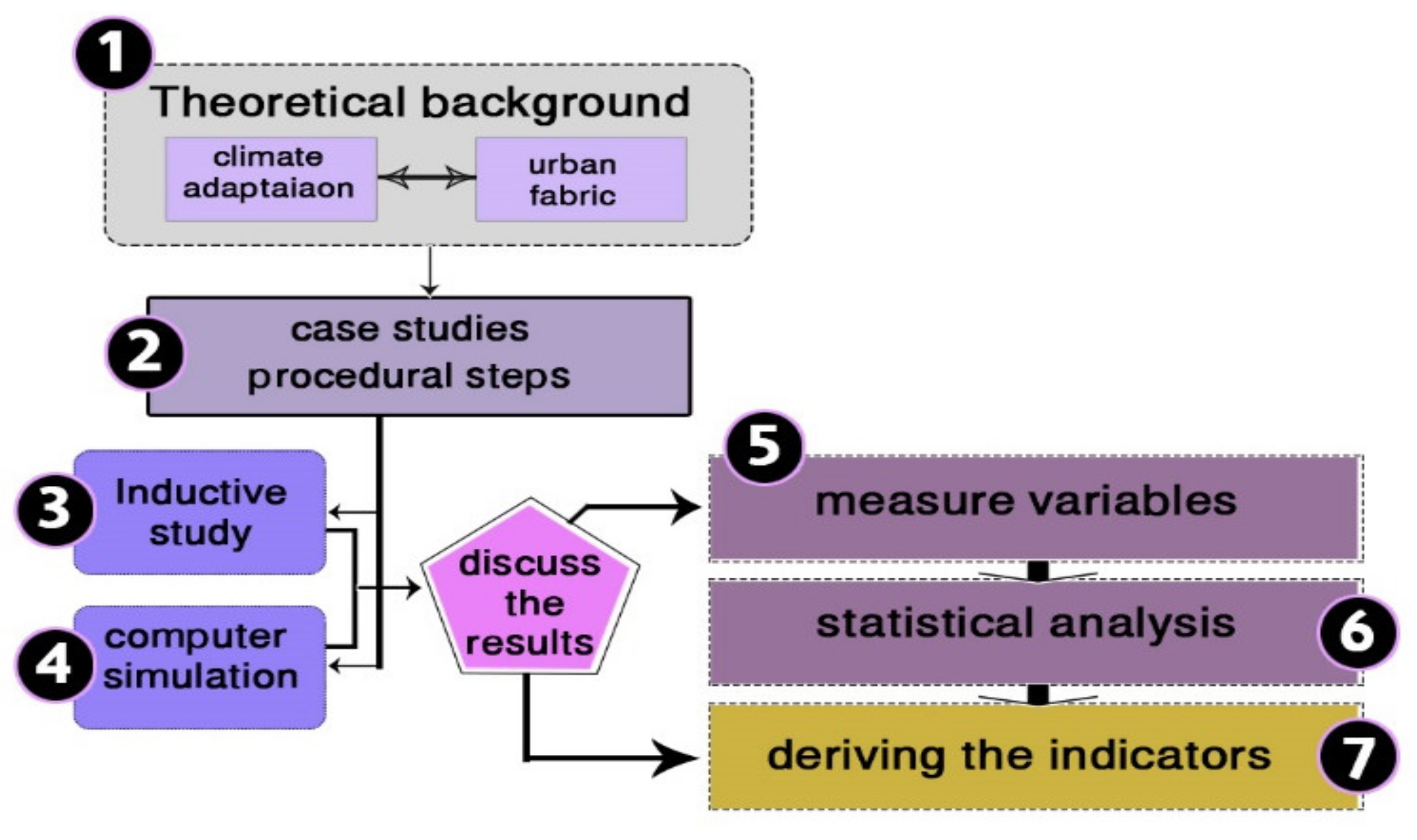





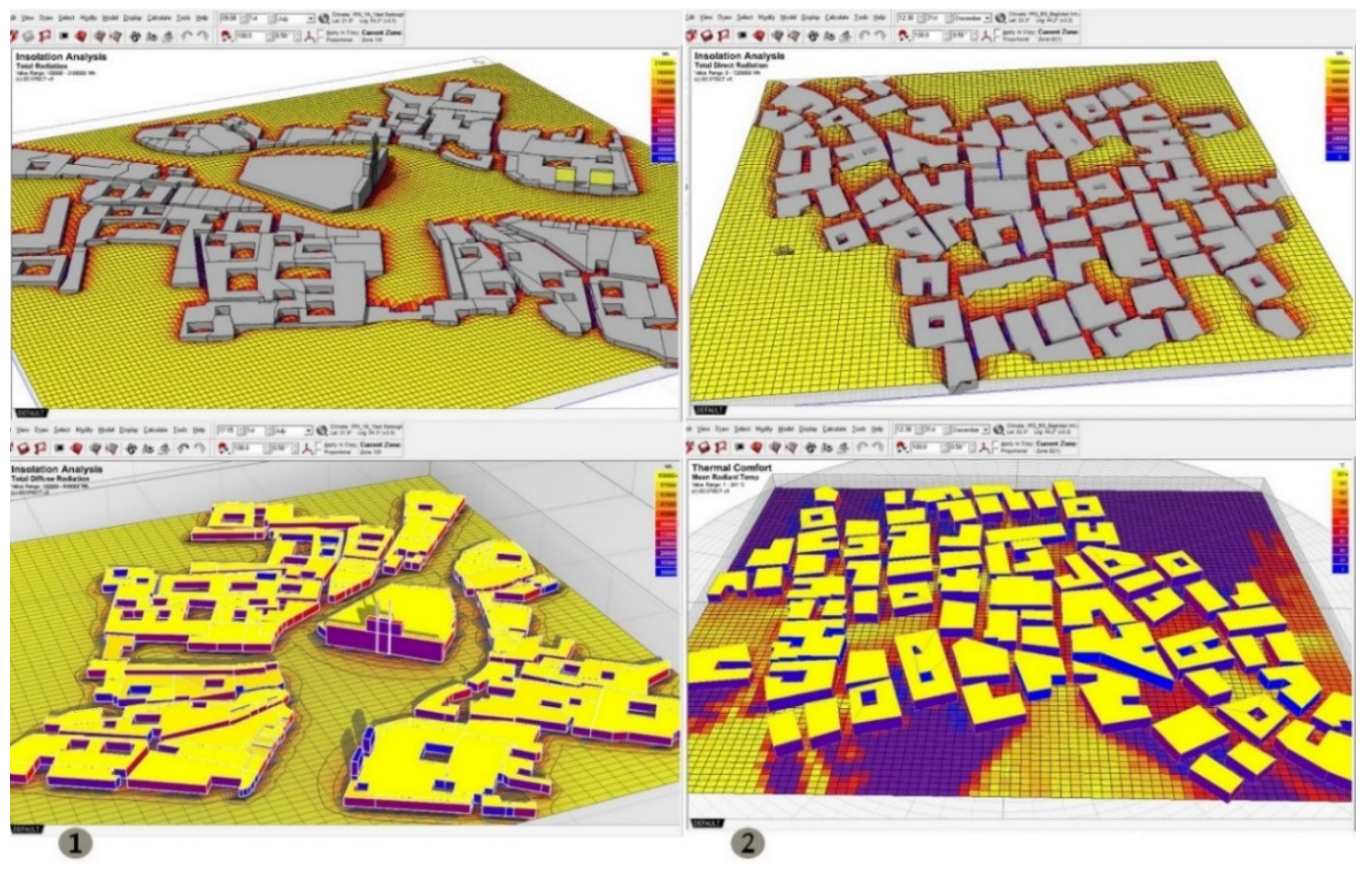
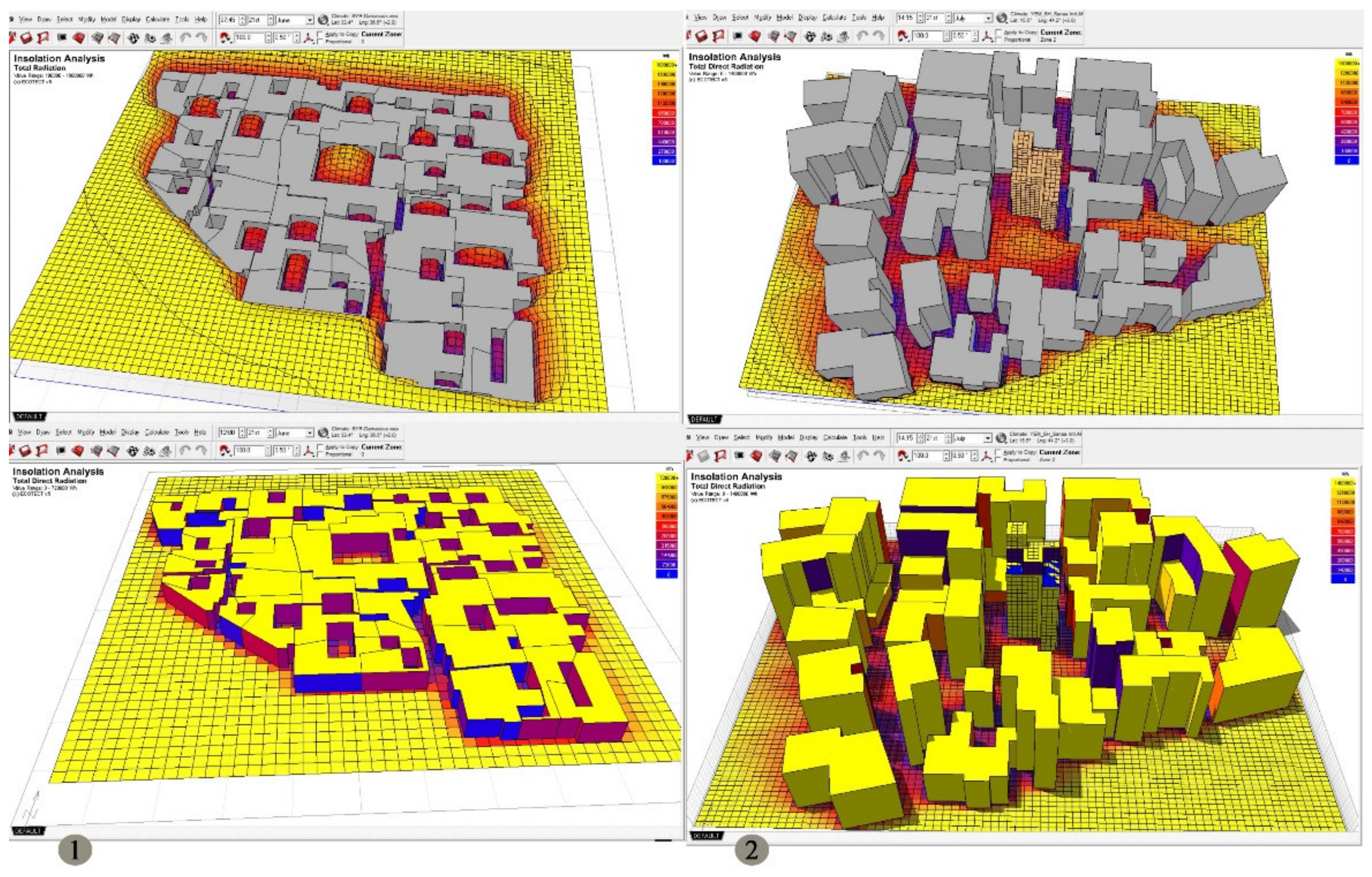
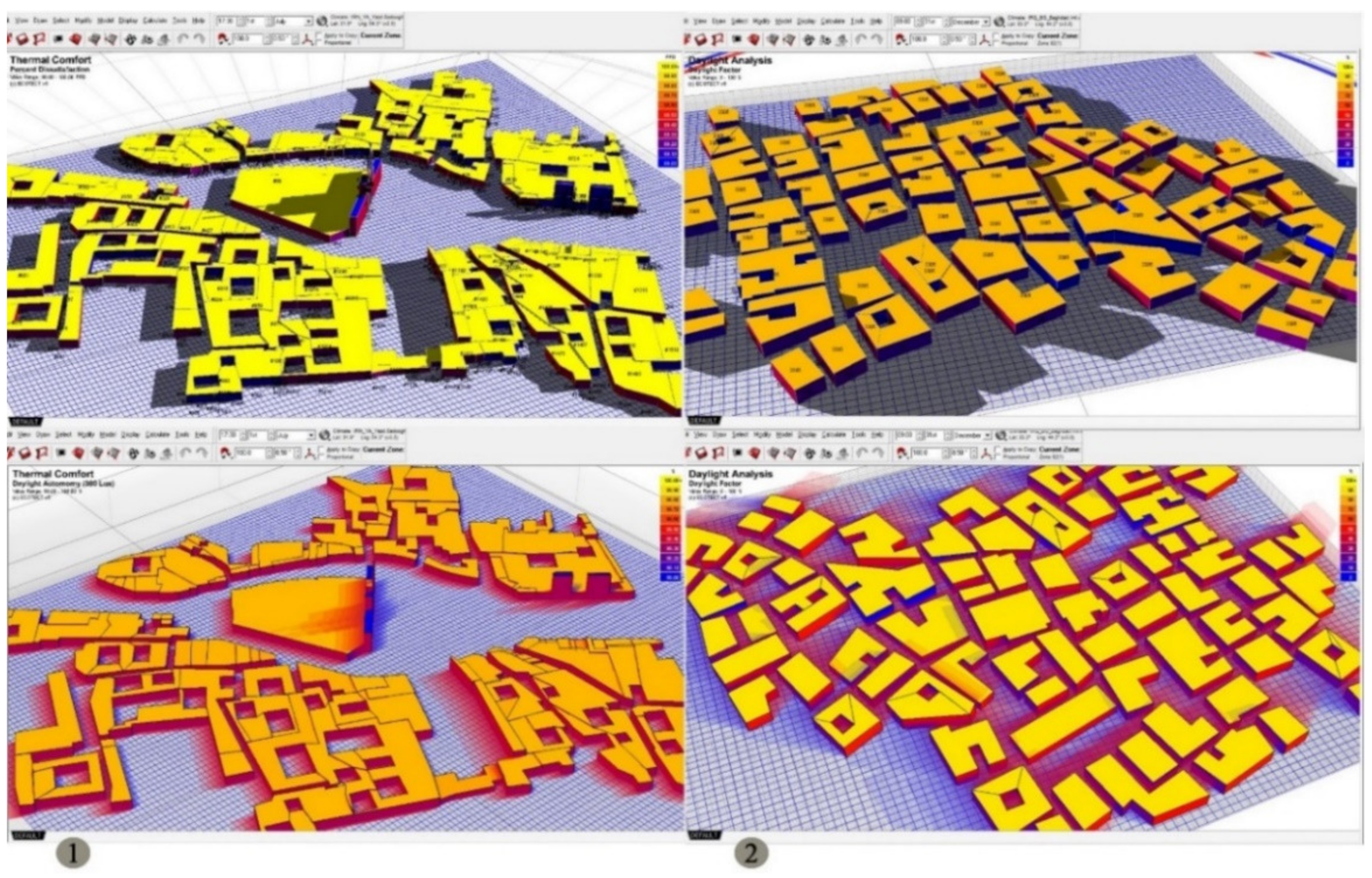
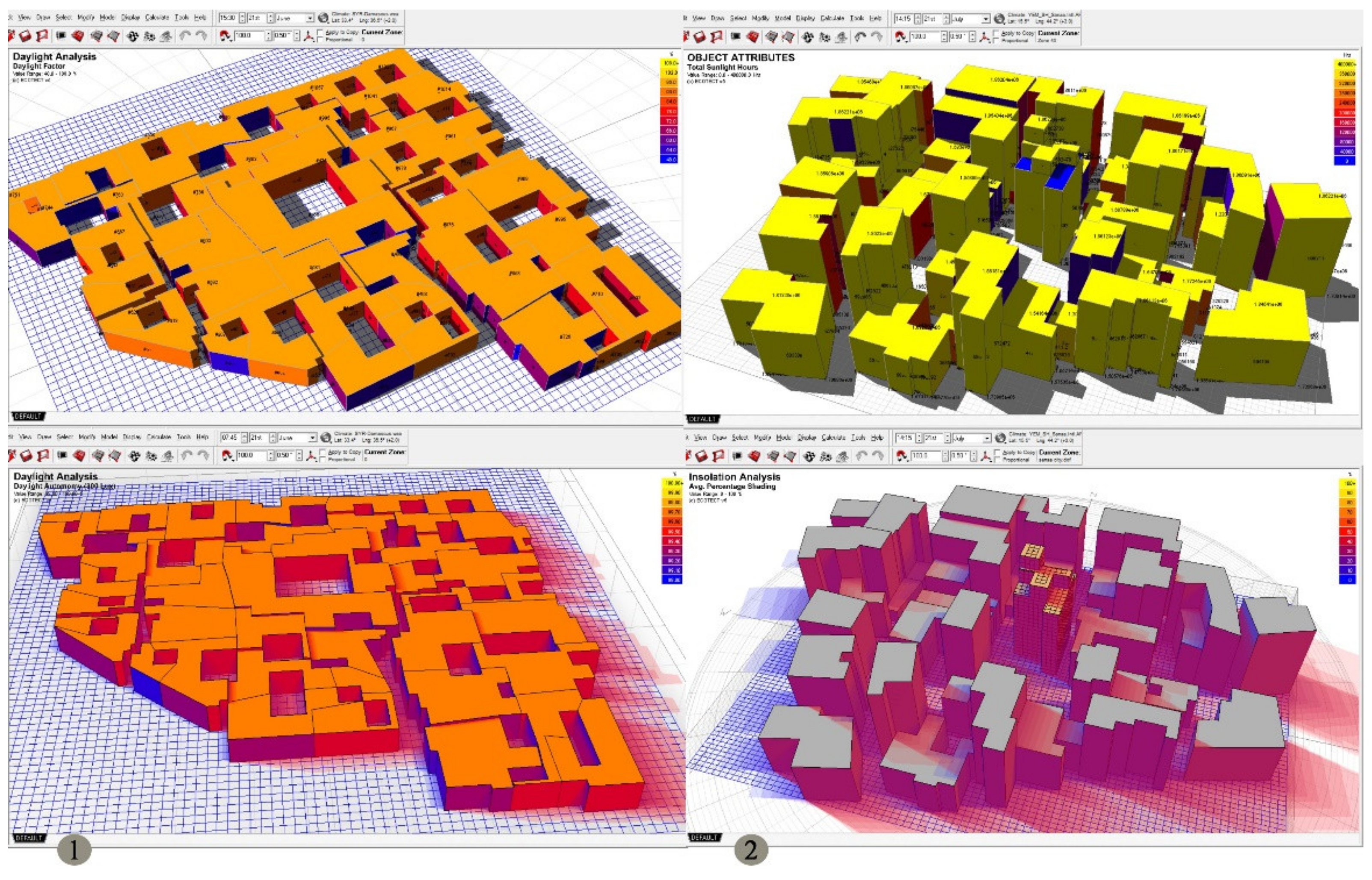
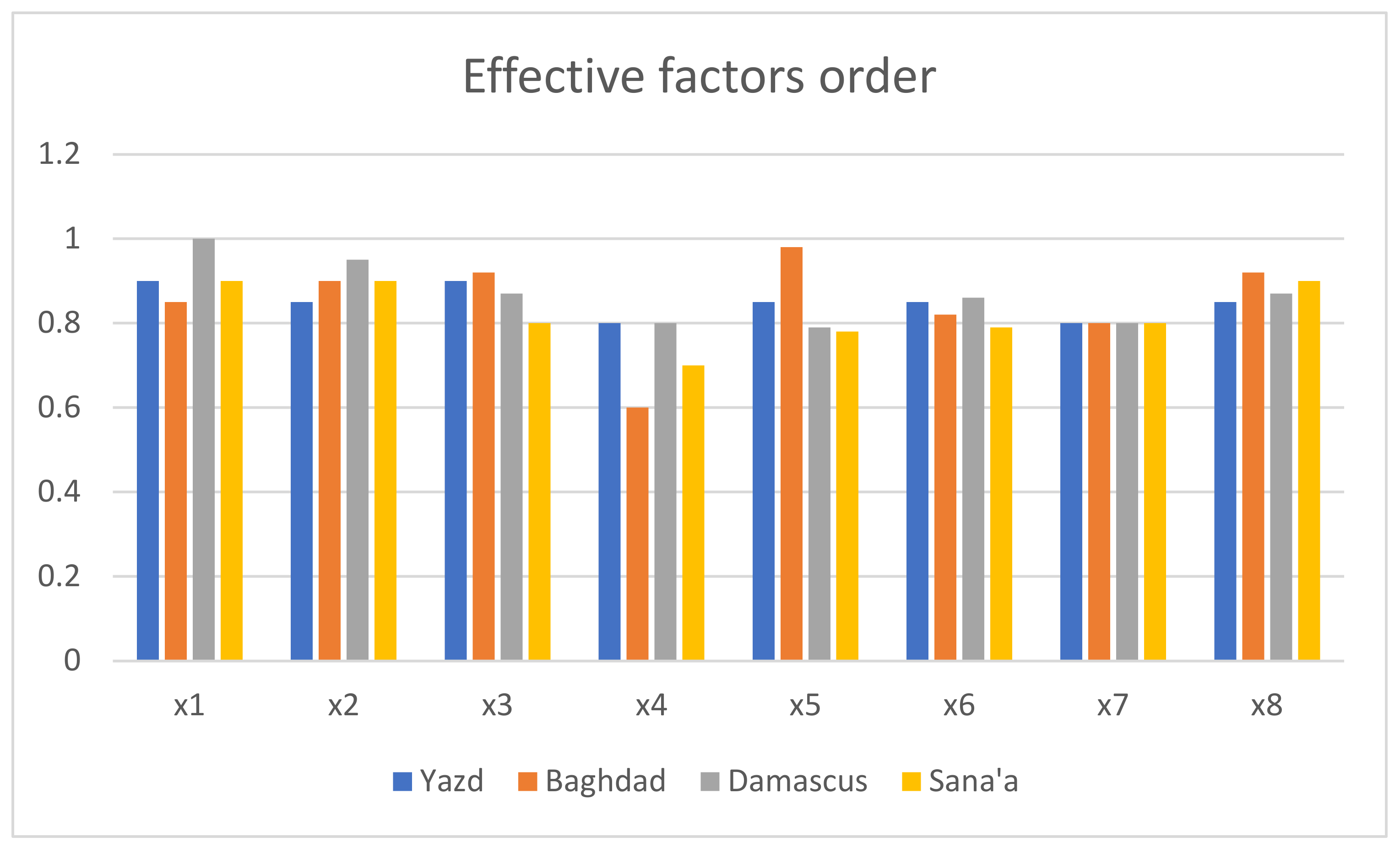
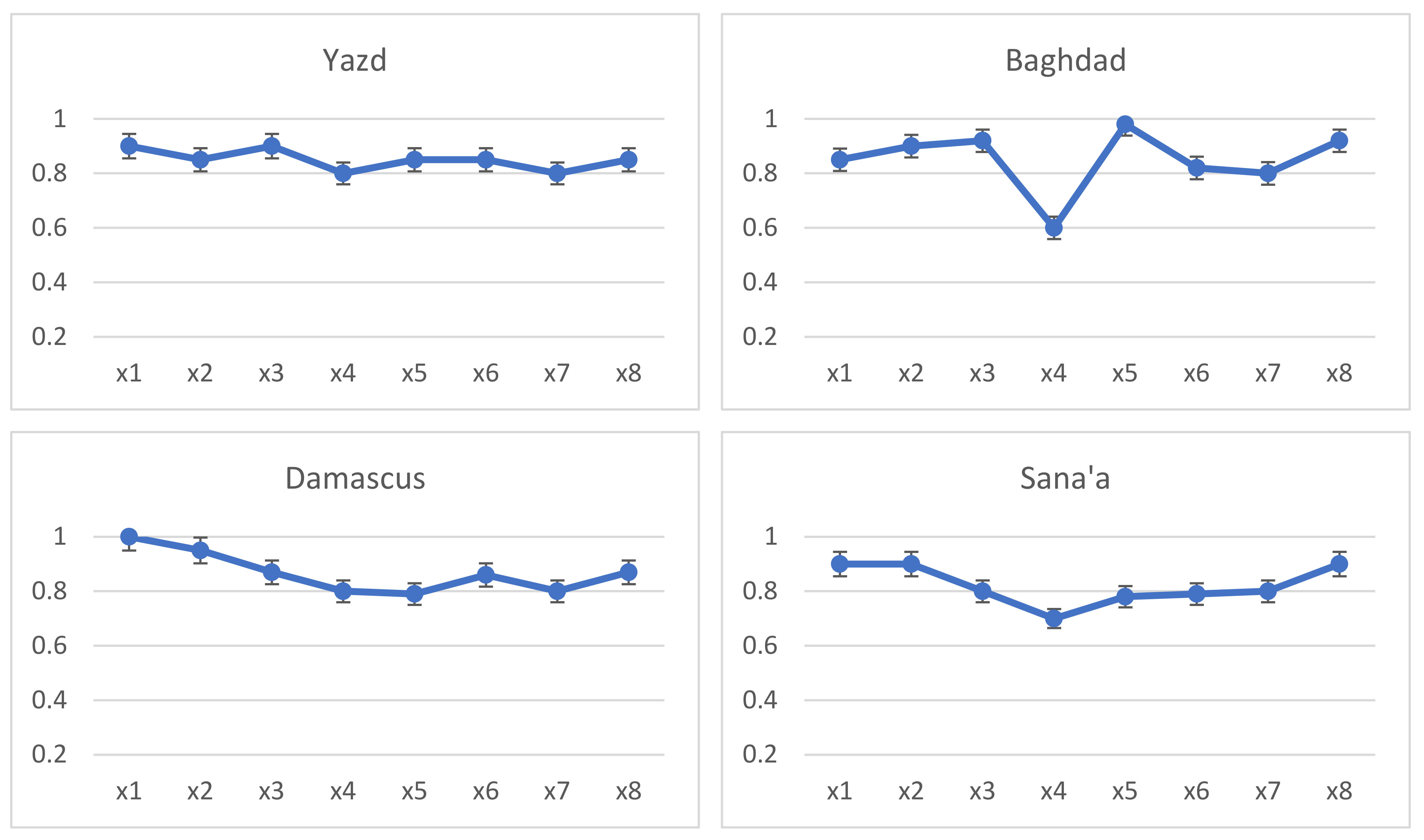
| Indicators | Yazd | Baghdad | Damascus | Sana’a |
|---|---|---|---|---|
| Urban fabric | Compact and convergence in residential groups and shaded alleys, private closed alleys to provide privacy for the residential group, and various public spaces for social events | Convergence and narrow alleys, inner courtyards to improve ventilation, grading in public squares according to social activities, and provide privacy by private courtyards | Organic and grid urban fabric and high compactness with adhesion in buildings, ensure privacy and neighborhood in residential blocks, public spaces only in front of public buildings and markets | Convergence from the vertical buildings, multiple winding alleys to provide natural lighting, alleys allow social communication, multiple public squares of various sizes according to social activities |
| Shape and dimensions of the streets and the orientation of the buildings | Main streets are shaded from the sun, with narrow alleys between buildings to avoid the insolation of the external facades, and internal courtyards are rectangular to achieve less insolation and greater shading | The streets are a grid of alleys with reduced orientation effect due to compaction and winding alleys and shading while avoiding summer rays through tiered facades with Shanasheel | Medium grid main streets spaced by residential high adhesion blocks to achieve the highest privacy and security, interspersed with short narrow alleys to prevent solar radiation access, with long facades in the east and west direction of the inner courtyards | Focus on building’s southern orientation, with long winding streets east–west to allow for the sunning of southern facades |
| The quality of spaces within the urban fabric | Diversity in the external public squares for religious and social activities, as well as markets, with a reliance on private open spaces for families, lack of entertainment spaces | Public spaces along the alleys that are used as markets on both sides with the decade of public squares for social activities and larger public squares to religious centers | Public spaces are small within the city, social communication is strengthened through holding markets, focus on privacy and protection, with orchards and outlets on the outskirts of the city | A wide variety of components and public spaces, squares, edifices, and markets are rich in social communication, lack of areas for children′s activities |
| Land use and density ratios | A high density that meets the requirements of the hot climate and social requirements for communication, distribution of uses to achieve privacy, ease of access, and dependence on the residence of the extended family | A high density that serves the requirements of a hot climate and social requirements for communication, protection, and unity, efficient use of the land to reduce horizontal expansion and dependence on the extended family residence | A high density that serves the requirements of a hot climate and social requirements for communication, protection, and unity, efficient use of the land to reduce horizontal expansion and dependence on the extended family residence | High density and vertical tower buildings that achieve a high economy of land use, provide ventilation and lighting, distribution of uses to achieve privacy, ease of access, and dependence on the residence of the extended family |
| Nature′s relationship with the built environment | Insert nature inside urban components through the multiple courtyards inside the residences, which contain trees and large pools of water | Use the afforestation in internal courtyards and fountains, as well as gardening in some public yards | House courtyards, trees and shrubs, wide fountains, and a water channel inside all the inner courtyards, some afforestation beside roads | Each group of houses is grouped around a backyard used as an orchard and a farm, with water canals to irrigate trees |
| Types of movement and the relationship between the components of the urban fabric | Alleys of the residential complexes are narrow and confined to pedestrians, marketplaces, religious centers, and city outskirts are available in main streets for the movement of vehicles | A network of narrow alleys interspersed by markets, limited to pedestrians and wheelbarrows, religious centers, and neighborhood edges with main streets for vehicular traffic | Narrow alleys that end at the entrances to the dwellings and are restricted to pedestrians, religious centers, and the edges of neighborhoods with main streets for vehicular traffic | A network of narrow alleys interspersed by markets, limited to pedestrians and wheelbarrows, religious centers, and neighborhood edges with main streets for vehicular traffic |
| Integration with the ecosystem | Domes, vaults, and other urban formations that provide shade, internal courtyards with water pools, and wind towers are integrated to form comfortable microclimates to achieve mitigation of harsh climate and revitalization of the ecosystem | Urban configuration provides shade and contrast in pressure to create air movement, courtyards with fountains and basements benefiting from the coolness of the earth layers to achieve mitigation of harsh climate and promote ecosystem | Urban configuration provides shade and contrast in pressure to create air movement, courtyards with fountains and basements benefiting from the coolness of the earth layers to achieve mitigation of harsh climate and promote ecosystem | The urban form of the city with tower buildings using sustainable local environment materials, building solutions in harmony with the climate and the green backyards, achieving integration and revitalization of the ecosystem |
| The shape of urban facades and skyline | Rhythm with a gradation of wind catchers and domes on the roofs, despite the prevailing horizontal extension, with window and grill details in the facades achieving a visually beautiful skyline and harmony with the environment | Shanasheel facades create shade and roof elements from wind sheds and rooftops with the district’s horizontality in an axis towards the most prominent and more significant elements represented in the religious buildings, achieving a balanced harmony with the components of the environment | Facades with large and prominent Mashrabiyas, horizontal symmetry with simple formations at the tops of the ceilings; this formation serves to promote visual beauty, reduces harsh climate effects, and protects from dust winds | Incredible richness in the formation of facades, decorations, and gradations of heights, achieving great benefit from the sun’s rays in the winter and ventilation from the passing winds and blocking of the solar rays in the summer |
| Indicators | Description | References |
|---|---|---|
| Urban fabric | The urban fabric determines the shape and sizes of the physical components of a city and how they can deal with climatic conditions. | [9,14,24,38] |
| Shape and dimensions of the streets and the orientation of the buildings | Solar rays are of paramount importance in hot, dry areas, so studying the orientation and shapes of streets and alleys between building blocks and directing them can achieve solar control. | [11,26] |
| The quality of spaces within the urban fabric | Ease of social communication and the achievement of cultural and social requirements in the design of public spaces. | [9,41,42] |
| Land use and density ratios | The density index, the compact environment, and the land use composition, while preserving the lands around the city, facilitate the possibility of shifting towards a sustainable environment. | [28,35] |
| Nature′s relationship with the built environment | Types of external and internal open green yards that incorporate the elements of nature into the built environment. | [22,31,37] |
| Types of movement and the relationship between the components of the urban fabric | Classifying and separating the types of movement to achieve safety, security, accessibility, and foot movement. | [10,35,39] |
| Integration with the ecosystem | Use bioclimatic planning strategies and support the continuation and integration of natural habitats and ecosystems. | [21,43,44] |
| The shape of urban facades and skyline | The use of 3D formations in the facades and skyline improves the microclimate in harmony with achieving the community′s cultural identity and the city. | [23,45] |
| Indicators | Code |
|---|---|
| Compact urban fabric | x1 |
| Origination of buildings and urban facades | x2 |
| Principle of streamlining spaces | x3 |
| Insertion of nature into the urban formation | x4 |
| Efficiency of land use | x5 |
| Integration with the ecosystem | x6 |
| Separating walking movement from the traffic movement | x7 |
| Urban facade formation | x8 |
| Indicators | Yazd | Baghdad | Damascus | Sana’a | Percentage |
|---|---|---|---|---|---|
| Compact urban fabric | 0.9 | 0.85 | 1 | 0.9 | 91% |
| Origination of buildings and urban facades | 0.85 | 0.9 | 0.95 | 0.9 | 90% |
| Principle of streamlining spaces | 0.9 | 0.92 | 0.87 | 0.8 | 87% |
| Insertion of nature into the urban formation | 0.8 | 0.6 | 0.8 | 0.7 | 73% |
| Efficiency of land use | 0.85 | 0.98 | 0.79 | 0.78 | 85% |
| Integration with the ecosystem | 0.85 | 0.82 | 0.86 | 0.79 | 83% |
| Separating walking movement from the traffic movement | 0.8 | 0.8 | 0.8 | 0.8 | 80% |
| Urban facade formation | 0.85 | 0.92 | 0.87 | 0.9 | 89% |
Publisher’s Note: MDPI stays neutral with regard to jurisdictional claims in published maps and institutional affiliations. |
© 2021 by the authors. Licensee MDPI, Basel, Switzerland. This article is an open access article distributed under the terms and conditions of the Creative Commons Attribution (CC BY) license (https://creativecommons.org/licenses/by/4.0/).
Share and Cite
Alabsi, A.A.N.; Wu, Y.; Koko, A.F.; Alshareem, K.M.; Hamed, R. Towards Climate Adaptation in Cities: Indicators of the Sustainable Climate-Adaptive Urban Fabric of Traditional Cities in West Asia. Appl. Sci. 2021, 11, 10428. https://doi.org/10.3390/app112110428
Alabsi AAN, Wu Y, Koko AF, Alshareem KM, Hamed R. Towards Climate Adaptation in Cities: Indicators of the Sustainable Climate-Adaptive Urban Fabric of Traditional Cities in West Asia. Applied Sciences. 2021; 11(21):10428. https://doi.org/10.3390/app112110428
Chicago/Turabian StyleAlabsi, Akram Ahmed Noman, Yue Wu, Auwalu Faisal Koko, Khaled Mohammed Alshareem, and Roknizadeh Hamed. 2021. "Towards Climate Adaptation in Cities: Indicators of the Sustainable Climate-Adaptive Urban Fabric of Traditional Cities in West Asia" Applied Sciences 11, no. 21: 10428. https://doi.org/10.3390/app112110428
APA StyleAlabsi, A. A. N., Wu, Y., Koko, A. F., Alshareem, K. M., & Hamed, R. (2021). Towards Climate Adaptation in Cities: Indicators of the Sustainable Climate-Adaptive Urban Fabric of Traditional Cities in West Asia. Applied Sciences, 11(21), 10428. https://doi.org/10.3390/app112110428







